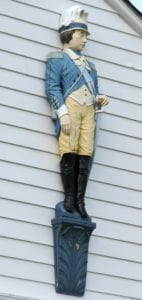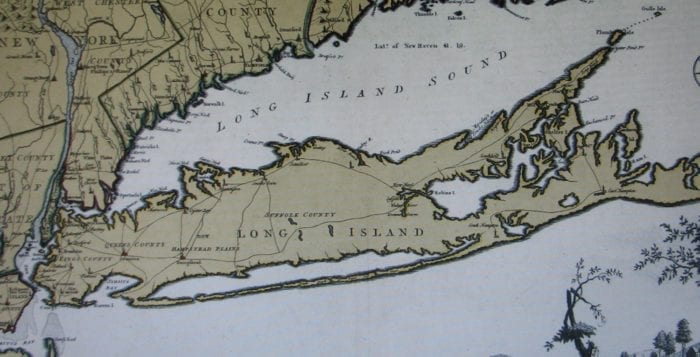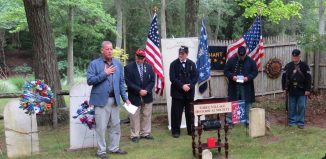Reflecting on those who made America’s independence possible
By Beverly C. Tyler
As we prepare to celebrate Independence Day, July 4, it is fitting to reflect on the actions of some of the men and women who helped win our independence.
The Revolutionary War had a great effect on the residents of Long Island. After the Declaration of Independence was signed July 4, 1776, many Long Islanders, especially in Suffolk County, received it enthusiastically. Their enthusiasm was short-lived, however, for on Aug. 27, 1776, the British took possession of New York City, following the Battle of Long Island in Brooklyn, and with its possession of all of Long Island. The residents were to be under British control for the next seven years.
“Since my arrival at camp I have had as large an allowance of fighting as I could, in a serious mood, wish for.”
— Benjamin Tallmadge
A large number of Long Island Patriots fled to Connecticut and became refugees, giving up their lands, homes and most of their possessions. Those who stayed lived under often harsh, military rule. The residents were forced to provide whatever His Majesty’s forces needed. Cattle, feed, grains, food, wagons and horses, especially cordwood for fuel was taken, and in most cases, not paid for. Long Island was virtually stripped of its mature trees during the first three to five years of the war to supply lumber and fuel for New York City.
In addition to suffering at the hands of the British, many Long Islanders were also considered fair game by their former friends and neighbors in Connecticut who would cross the Sound to harass the British, steal supplies, destroy material the British might use and take captives. The captives were often taken in exchange for the Patriots captured by the British.
Benjamin Tallmadge, Gen. George Washington’s chief of intelligence from the summer of 1778 until the end of the Revolutionary War, was born and spent his youth in Setauket, Long Island. Following four years at Yale College in New Haven and a year teaching in Wethersfield, Connecticut, Tallmadge joined the Continental Army. He took an active part in the Battle of Brooklyn and progressed rapidly in rank. As a captain in the 2nd Regiment of Continental Light Dragoons — Washington’s first fast attack force mounted on horses — Tallmadge came under Washington’s notice. By December of 1776, Washington had asked Tallmadge, in addition to his dragoon responsibilities, to gather intelligence from various spies on Long Island. In 1777 Tallmadge coordinated and received intelligence from individual spies on Long Island. (See History Close at Hand article published in The Village Times Herald May 10 edition.)

Tallmadge was promoted to the rank of major April 7, 1777. In June Tallmadge’s troop, composed entirely of dapple gray horses, left their base at Litchfield, Connecticut, and proceeded to New Jersey where Washington reviewed the detachment and complimented Tallmadge on the appearance of his horsemen.
Washington gave the troops of the 2nd Regiment little chance to rest after they came to headquarters, and Tallmadge wrote, “Since my arrival at camp I have had as large an allowance of fighting as I could, in a serious mood, wish for.”
In September and October, Tallmadge took part in the Battle of Germantown. In November of 1777, when the American army finally went into winter quarters at Valley Forge, Tallmadge was ordered, “with a respectable detachment of dragoons,” to act as an advance corps of observation.
During these maneuvers into the no-mans-land area between the American and British lines around Philadelphia, Tallmadge again engaged in obtaining intelligence of the enemy’s movements and plans.
In January of 1778, the 2nd Regiment of Light Dragoons was ordered to Trenton, New Jersey, where the other cavalry regiments were assembling to spend the winter. Throughout the spring, Tallmadge waited for action. In June the 2nd Regiment was assigned to take up a position in advance of the American lines near Dobbs Ferry. In July Washington returned to the Hudson Valley with most of his army. With the arrival of the French fleet under Count d’Estaing in July, the pressing need for organized military intelligence could no longer be avoided. Officers, and especially dragoon officers, were encouraged to find intelligent correspondents who could furnish reliable information to American headquarters.
During the summer of 1778, Tallmadge was able to establish, with Washington’s approval, a chain of American spies on Long Island and in New York, the now recognized Culper Spy Ring, feeding information through Setauket, across Long Island Sound to Fairfield, Connecticut, and by mounted dragoon to Washington’s headquarters. Despite Tallmadge’s important role in the formation of the spying operation, his duties as field officer of the 2nd Regiment took most of his time during the summer and fall of 1778. The men and women who made the spy ring function lived in constant danger in both British and Patriot territory. We owe them the greatest respect and honor we can offer, especially on July 4.
Beverly C. Tyler is Three Village Historical Society historian and author of books available from the society at 93 North Country Road, Setauket. For more information, call 631-751-3730 or visit www.tvhs.org.







